|
|
|||
|
(Back to Preceding Week; on to Next Week) |
|
WHEN IT'S DREARY AND COLD |
|
MAYFLOWER QUIZ 2009: For the preceding installment of "This Week at Hilton Pond," we offered a Mayflower Quiz--not a test about the Pilgrims' ship (below right) but a sampling of flora we've seen blooming during May at Hilton Pond Center or in central West Virginia. We urged site visitors to look at our images of flowers--some herbaceous, others from vines or shrubs or trees; all photos were "Mayflowers," i.e., they were taken 1-21 May 2009. Minor hints were provided for each blossom, including whether the plant was found around Hilton Pond or in the Mountain State. Participants e-mailed their lists to us by 27 May 2009, with our promise the person who submitted the most correct and complete IDs (common name, plus genus & species) would win an Operation RubyThroat T-shirt. In case of a tie--which didn't happen--a blind drawing would determine the winner. (Special consideration was given to anyone who got the "Bonus Flower.") We're pleased to announce we had more than four dozen entries. No one knew all the IDs, but we have declared a "winner." First, however, we'll provide the correct answers and a little more natural history info about each of our "Mayflowers." (To view larger versions of the images, see last week's installment.) All text & photos © Hilton Pond Center 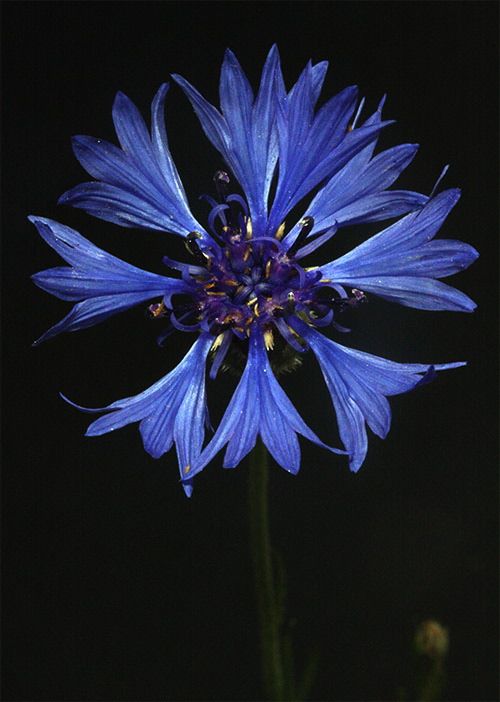 FLOWER #1: Fallow farmland--and a grassy roadside near Hilton Pond Center--is often carpeted with these elegant blue blossoms. We've also seen varieties in purple, pink, or white. The plant often disappears after a field is two years into natural succession. FLOWER #1: Fallow farmland--and a grassy roadside near Hilton Pond Center--is often carpeted with these elegant blue blossoms. We've also seen varieties in purple, pink, or white. The plant often disappears after a field is two years into natural succession.The Answer: Bachelor's Button or Common Cornflower, Centaurea cyanus (Linnaeus). This non-native annual species was likely introduced from England two centuries ago; although it is invasive in North America, it is now endangered in its native habitats in the United Kingdom. The dark blue flower is ground up and used to dye cloth and the leaves are added to teas--particularly the Lady Grey blend of Twinings. (The most common incorrect ID for this flower was Chicory, Cichorium intybus, also an invasive from Europe and another tea additive.) P.S. This plant is a sunflower.
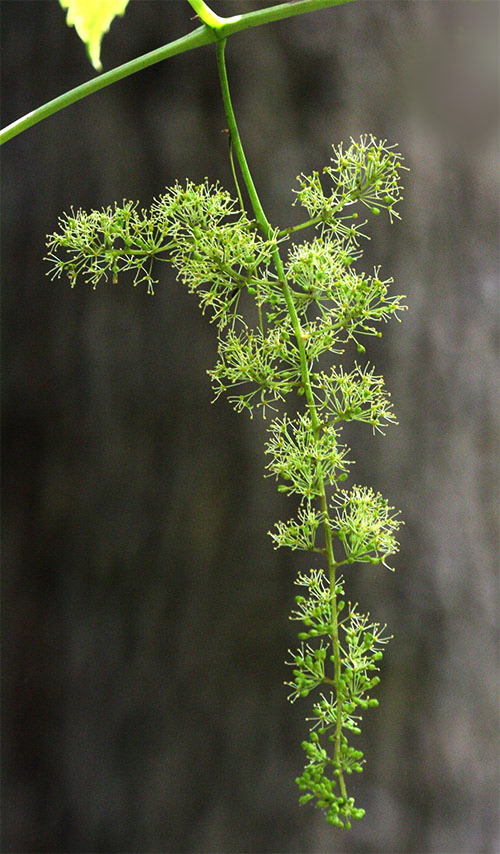 FLOWER #3: A dangling cluster of flowers like these--growing on a woody deciduous vine at Hilton Pond Center--could be produced only by one family. The hard part is figuring out the species. FLOWER #3: A dangling cluster of flowers like these--growing on a woody deciduous vine at Hilton Pond Center--could be produced only by one family. The hard part is figuring out the species.The Answer: Frost Grape, Vitis vulpina (Linnaeus). Without leaves or tendrils in the photo, this wild grape was a toughie. The dense dangling cluster of blossoms rules out the more sparsely flowered Summer Grape, V. aestivalis, but not the Muscadine. V. rotundifolia. However, the flower- and fruit-bearing vine of the latter tends to be woody and brown. (The clincher comes after the fruits appear, of course; we have the advantage of knowing from experience the vine in the photo will make tiny, quarter-inch, dark purple grapes much smaller than those of a Muscadine.) One person did get the species on this one (although it was misspelled); most folks went with V. aestivalis or just took the vine to genus. Frost Grape is so-called because it often holds its fruit into the winter months.
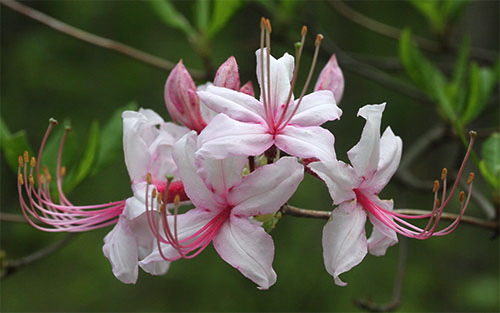 FLOWER #5: Although two-inch-wide blossoms of this deciduous shrub can be found at Hilton Pond Center in early April, this photo was taken in May in the West Virginia mountains. The five stamens and single pistil are especially long. FLOWER #5: Although two-inch-wide blossoms of this deciduous shrub can be found at Hilton Pond Center in early April, this photo was taken in May in the West Virginia mountains. The five stamens and single pistil are especially long.The Answer: Pinxter-flower, Rhododendron periclymenoides (Michaux), formerly R. nudiflorum, is a "wild azalea" that occurs in rich woodlands across the eastern U.S. to southern New England and west to Illinois. It is similar to Sweet Mountain Azalea, R. canescens, which is NOT reported from West Virginia where the photo was taken. (That said, a big evergreen rhododendron, R. maximum--the Rosebay--is the state flower of the Mountain State.) The name "pinxter" comes not from the flower's coloration but from the Dutch words Pinxter blomachee, which relate to the fact that this is supposedly the azalea that blossoms on Pentecost, 50 days past Easter. It blooms much earlier here at Hilton Pond Center; if, as we suspect, this plant is also visited by Ruby-throated Hummingbirds, it may be one of those early spring blossoms our initial wave of hummers relies upon during the first two weeks in April when little else is in bloom.
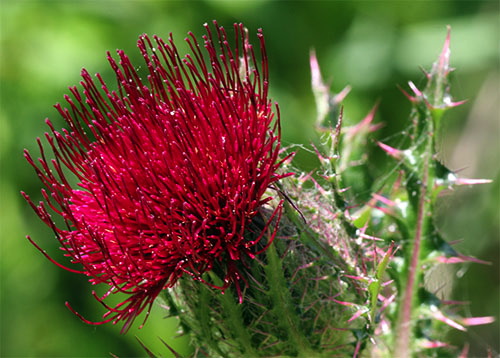 FLOWER #7: Despite its attractive deep red color, this two-inch wide blossom in Hilton Pond's Goldenrod Meadow probably isn't one you'd be wanting to wear as a corsage or boutonniere at your next formal dance. Ouch! FLOWER #7: Despite its attractive deep red color, this two-inch wide blossom in Hilton Pond's Goldenrod Meadow probably isn't one you'd be wanting to wear as a corsage or boutonniere at your next formal dance. Ouch!The Answer: Bull Thistle, Cirsium vulgare (Savi). This Mayflower turned out to be a tough one, only because the blossom's deep red color is so different from the lavender shades we usually see in this species. (Don't fret; the local botanist sweated over this one, too.) Oddly, ALL the Bull Thistles in the Goldenrod Meadow at Hilton Pond Center are red; thus, the plants likely are all from the same genetic line, but we're not sure if it is relatedness or something in our soil that makes these particular plants produce such reddish blossoms. By the way, like Flowers #1 (above) and #8 (below), all thistles are composite flowers, i.e., they're in the Sunflower Family (Asteraceae).
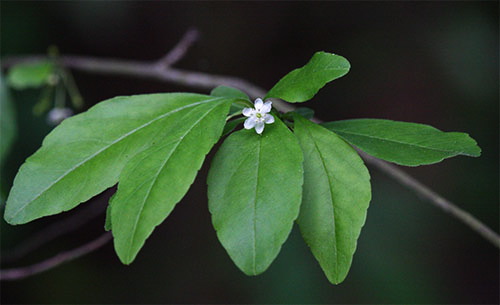 FLOWER #9: Although this photo focuses on a single white quarter-inch flower, the deciduous shrub bearing it usually makes blossoms in drooping clusters (see out-of-focus cluster in the background at upper left). This shrub is growing slowly at Hilton Pond Center. FLOWER #9: Although this photo focuses on a single white quarter-inch flower, the deciduous shrub bearing it usually makes blossoms in drooping clusters (see out-of-focus cluster in the background at upper left). This shrub is growing slowly at Hilton Pond Center.The Answer: Deciduous Holly or Possum Haw, Ilex decidua (Walter). This was a "problem plant" for our contest participants, with no one getting it correct to species level; most folks left the answer blank. Those who tried called it a deciduous holly, which seemingly would be incorrect because most hollies have four petals per flower; after all, the photo shows six petals on our mystery plant. However, in some deciduous hollies the staminate (male) flowers--which occur on different plants than pistillate (female) flowers--have five to seven petals, which fits our photo. The deciding character is lightly scalloped leaves with rounded rather than pointed tips. Possum Haw produces red berries we've never seen locally, so we're guessing Hilton Pond Center has only male shrubs of this species.
 BONUS FLOWER: This flower was growing abundantly in a remote location (Bone Valley Creek) within Great Smoky Mountains National Park. Its somewhat rounded leaves are relatively thick and succulent. The site is likely an old homestead, long since taken over by nature. BONUS FLOWER: This flower was growing abundantly in a remote location (Bone Valley Creek) within Great Smoky Mountains National Park. Its somewhat rounded leaves are relatively thick and succulent. The site is likely an old homestead, long since taken over by nature.The Answer: Woodland Stonecrop, Sedum ternatum (Michaux). Jim Casada, a friend and outdoor writer who frequently submits enlightening commentary about our "This Week at Hilton Pond" postings, was hiking in the Smokies with his brother and encountered this interesting but unfamiliar plant. We figured it would stump a lot of contest participants but were pleased about a quarter of submissions correctly identified it. Some folks, however, referred to it as an invasive non-native--which is doubly incorrect; it occurs naturally in much of the eastern U.S. and Ontario and doesn't seem to crowd out other flora. It grows best in rocky areas and, as a succulent, might be a nice plant to try in xeriscapes.
All text & photos © Hilton Pond Center
Bonus flower photo courtesy Jim Casada AND THE WINNER IS . . . (Drum roll, please.) Andrea Cook (below right) of Charlotte NC--not far from Hilton Pond--had six species exactly correct (common name, plus genus & species), with proper genus names for three more. She also got the bonus plant. We'll be sending Andrea one of our highly coveted Operation RubyThroat T-shirts in this week's mail. Congratulations to her, and thanks to everyone who submitted an entry in our Mayflower Quiz 2009. All text & photos © Hilton Pond Center
Comments or questions about this week's installment?
Thanks to the following fine folks for recent gifts in support of Hilton Pond Center for Piedmont Natural History and/or Operation RubyThroat: The Hummingbird Project. Your tax-deductible contributions allow us to continue writing, photographing, and sharing "This Week at Hilton Pond." (Please see Support if you'd like to make a gift of your own. You can also contribute by ordering an Operation RubyThroat T-shirt.)
"This Week at Hilton Pond" is written & photographed You may wish to consult our Index of all nature topics covered since February 2000. You can also use our on-line Hilton Pond Search Engine at the bottom of this page. For a free, non-fattening, on-line subscription to |
|
Make direct donations on-line via
Network for Good: |
|
|
Use your PayPal account
to make direct donations: |
|
|
If you like to shop on-line, you please become a member of iGive, through which more than 750 on-line stores from Barnes & Noble to Lands' End will donate a percentage of your purchase price in support of Hilton Pond Center and Operation RubyThroat. For every new member who signs up and makes an on-line purchase iGive will donate an ADDITIONAL $5 to the Center. Please sign up by going to the iGive Web site; more than 200 members have signed up to help. It's a painless, important way for YOU to support our on-going work in conservation, education, and research. |
|
|
SPECIES BANDED THIS WEEK: * = New species for 2009 WEEKLY BANDING TOTAL 8 species 12 individuals YEARLY BANDING TOTAL (2009) 29 species 987 individuals 28-YEAR BANDING GRAND TOTAL (since 28 June 1982, during which time 170 species have been observed on or over the property) 124 species 52,869 individuals NOTABLE RECAPTURES THIS WEEK (with original banding date, sex, and current age) Carolina Chickadee (1) Eastern Towhee (1) Eastern Tufted Titmouse (1)
|
OTHER NATURE NOTES OF INTEREST --Near-daily frogstranglers made it difficult to run mist nets during the week, resulting in few banded birds and more than 7" of precipitation in the trusty old rain gauge. The good news: Hilton Pond is full at the end of May for the first time in many years. --Mornings and evenings this week we were reminded not everything about springtime and May is pleasant. In particular, the heavy stench of Chinese Chestnut blossoms filled the air and fouled the nostrils. (It's so hard to describe in words how something smells, or stinks--one reason we wish we had a way to post "scratch 'n' sniff" odors for Web site visitors.)
|
|
|
|
(Back to Preceding Week; on to Next Week) Up to Top of Page Back to This Week at Hilton Pond Center Current Weather Conditions at Hilton Pond Center |
 You can also post questions for The Piedmont Naturalist |
Join the |
Search Engine for |
|
|
Boingo Internet Access

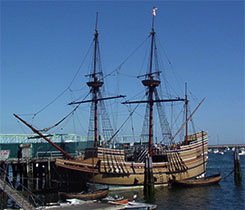 We expected some IDs would be easy and others would cause a little head-scratching. (In response, one quizzee said he had graduate-level botany tests easier than the Mayflower Quiz!)
We expected some IDs would be easy and others would cause a little head-scratching. (In response, one quizzee said he had graduate-level botany tests easier than the Mayflower Quiz!) FLOWER #2: Leathery green leaves with parallel veins might help you identify this plant before it blooms, but once the pink blossom erupts there's no mistaking this wildflower. Although the photo was taken at the New River Birding & Nature Center in West Virginia, we've seen this plant in such odd places as a drainage ditch within the city limits of Rock Hill SC.
FLOWER #2: Leathery green leaves with parallel veins might help you identify this plant before it blooms, but once the pink blossom erupts there's no mistaking this wildflower. Although the photo was taken at the New River Birding & Nature Center in West Virginia, we've seen this plant in such odd places as a drainage ditch within the city limits of Rock Hill SC.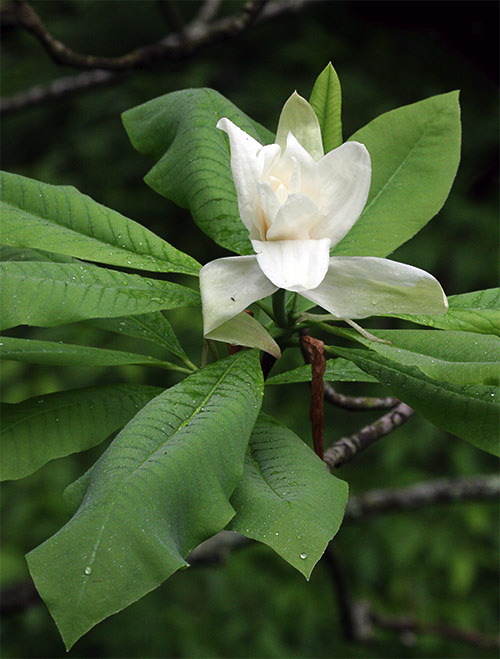 FLOWER #4: Produced on a tall understory tree with foot-long deciduous leaves, this large white flower in West Virginia's Fayette County reminds of us its southern relative.
FLOWER #4: Produced on a tall understory tree with foot-long deciduous leaves, this large white flower in West Virginia's Fayette County reminds of us its southern relative.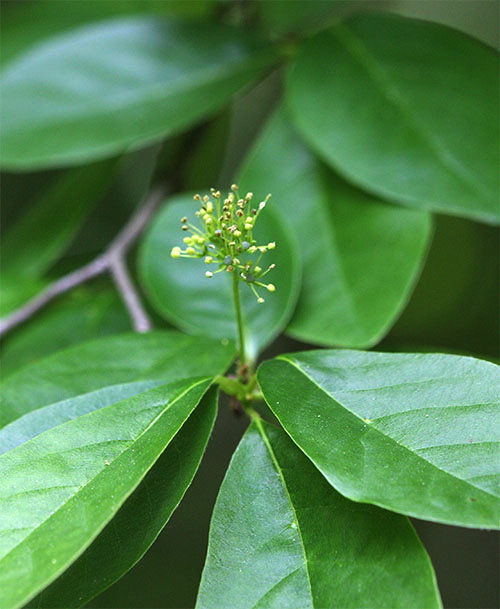 FLOWER #6: This nondescript cluster of MALE flowers emerges from a woody twig on a tree with shiny green oval-shaped deciduous leaves. The species is especially common in somewhat moist habitats across the eastern U.S.; here at Hilton Pond it was growing not far from the water's edge.
FLOWER #6: This nondescript cluster of MALE flowers emerges from a woody twig on a tree with shiny green oval-shaped deciduous leaves. The species is especially common in somewhat moist habitats across the eastern U.S.; here at Hilton Pond it was growing not far from the water's edge.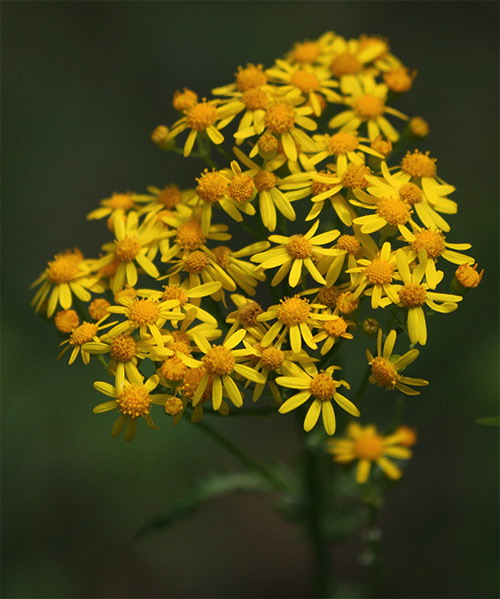 FLOWER #8: We couldn't have a Mayflower quiz without at least one example of what the botanists frustratingly call a DYC ("damned yellow composite.") This cluster of flowers was atop a two-foot-tall stalk in an open meadow at Hilton Pond Center.
FLOWER #8: We couldn't have a Mayflower quiz without at least one example of what the botanists frustratingly call a DYC ("damned yellow composite.") This cluster of flowers was atop a two-foot-tall stalk in an open meadow at Hilton Pond Center.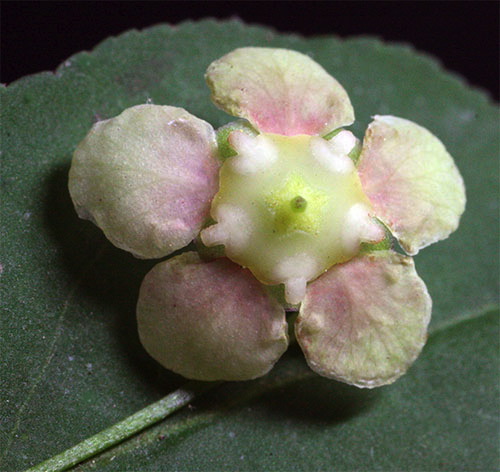 FLOWER #10: Fruit from the easily overlooked 3/8" flowers on this green-stemmed shrub seemingly burst from their pods when ripe. The plant is common in shady spots around Hilton Pond Center but often gets browsed by White-tailed Deer.
FLOWER #10: Fruit from the easily overlooked 3/8" flowers on this green-stemmed shrub seemingly burst from their pods when ripe. The plant is common in shady spots around Hilton Pond Center but often gets browsed by White-tailed Deer.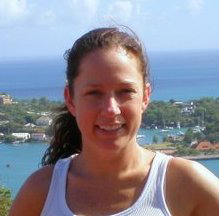 Kathy Marie Garness of Forest Park IL came close to tying with Andrea but left out a common name and used the old name for Pinxter-flower--Rhododendron nudiflorum--instead of its currently accepted tongue-twisting epithet Rhododendron periclymenoides, so Andrea gets the prize. Andrea is an ecologist working for HDR on streams, wetlands, and endangered species to "help keep our clients on the right side of various environmental laws and regulations." Andrea says "I frequently check in on what's going on at the Hilton Pond website; it's like having a guide to what's happening in my own backyard each month."
Kathy Marie Garness of Forest Park IL came close to tying with Andrea but left out a common name and used the old name for Pinxter-flower--Rhododendron nudiflorum--instead of its currently accepted tongue-twisting epithet Rhododendron periclymenoides, so Andrea gets the prize. Andrea is an ecologist working for HDR on streams, wetlands, and endangered species to "help keep our clients on the right side of various environmental laws and regulations." Andrea says "I frequently check in on what's going on at the Hilton Pond website; it's like having a guide to what's happening in my own backyard each month."

 Please report your
Please report your